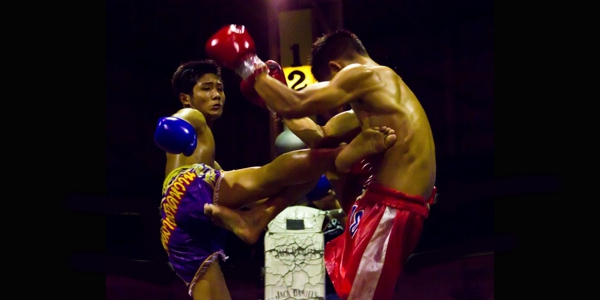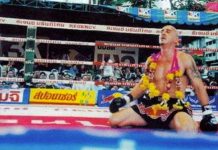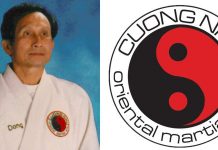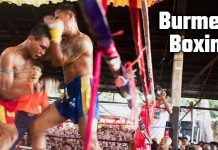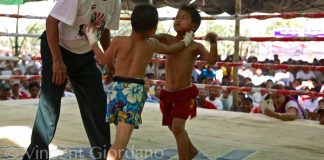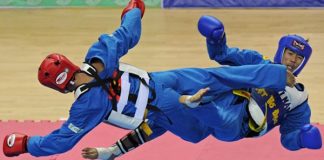“Ten in a row on each side.” Said the coach.
If he had been talking about punches I might have been OK. But it was the last few minutes of grueling, two-hour training session, and he was talking about kicks.
I sweat about five liters of water during these workouts, and one reason I circle in the ring is so I can move away from the puddle that dripped down my legs like I had had an accident.
I was panting, heaving, exhausted, and the coach wanted ten more on each side.
Some of the kicks were terrible, like a shaky old man swatting at a naughty boy with his cane. When I threw a good kick, the coach would say, “Narak!” which, in Thai, means cute. And I wasn’t sure how to feel about that. Did it mean, that I had kicked correctly? Did it mean, that I was so weak my kicks were cute rather than frightening? Or, did it mean I was cute when I kicked. I was wearing my blue Muay Thai shorts, the ones that don’t make me look fat, so one never knows.
The coach’s face was a roadmap of scars and pockmarks. He never smiled, but sometimes his lips parted and you could see that he was missing all of his front teeth. I decided to concentrate on my kicks. The coach was sort of hard to look at.
Around the world, MMA has been steadily gaining popularity and is now one of the most watched combat sports on cable TV. The original intent of the competition was to see if Karate could beat Kung Fu, or if boxing was better than Aikido. This comparison of styles only lasted for about the first six competitions, by which time most professional fighters had agreed that the most popular grappling art was either Brazilian Jiu Jitsu and the best stand up striking art was Muay Thai. I am not an expert grappler, and don’t want to receive hate mail from practitioners of Russian Sambo and other arts, telling me there art is more effective. It may very well be. But for the moment, Brazilian Jiu Jitsu and western wrestling are the two arts that one can find anywhere in the world to train and practice.
With stand up striking there are a number of arts competing to be recognized as the best striking art. Philippine Yan, Japanese Kiukushin, Chinese San Da (San Shau) and Cambodian Bradal Serey are the leading runners up. But for the moment, the only country which has sufficient infrastructure to support thousands of foreign fighters is Thailand. There nearly one-hundred thousand registered boxer in Thailand. There are schools, ranging from posh, hotel-like training centers which teach in English and cater exclusively to foreigners, to hard-core, sleep on the floor boxing camps, where you can train for free against a large percentage of your winnings.
As for competitions and experience, in Cambodia or Philippines, professional fighters are scrambling to find venues. The same Yaw Yan guys turn up in kick boxing, karate, MMA, and even grappling tournaments, just to have a place to fight. In Thailand, there are multiple professional fights, every single day in every city. The way this all plays out for foreign fighters coming to Asia to train, in Thailand, you can chose from a wide range of schools or camps for your training. And, when you feel ready, you could start fighting pro, as many times per month as you wanted. Thailand also has a well-established ranking and tournament series. So, when you win a title in Thailand, it is real.
I received an email once from the San Da champion of the United States. How many San Da fights re there anualy in USA? How many people belong to the federation? How many are in each weight category? And how many did he have to fight to win? For many of these obscure arts, the champion is the winner of a single, annual tournament. Whereas with pro-boxing in the states, or pro Muay Thai in Thailand, fighters climb up a long slippery ladder, winning and loosing, scrambling from a sea of thousands, to be the best.
Thailand is where I first learned kick boxing, years ago. Afterwards, I continued the training in Cambodia, Philippines, Loa, and China. But Thailand is where I often return to get back into shape. So, after a stint in Philippines boxing and learning stick and knife fighting, I went “home” to Thailand, to train at Kawila, the big boxing stadium in Chiang Mai.
Training at Kawila only costs 200 Baht per session, or that is what I paid after negotiations. The facilities were basic, two heavy bags, a full size ring and a few odds and ends. Obviously, you will want to take your shower and change clothes at home.
The thing I like about kawvila and most of the other not-so-famous gyms I find in Thailand is that I was either the only foreigner or maybe one of two. The instructors didn’t speak a lot of English, so I got practice my Thai. And of course, in the small gyms you get a lot of personal attention. The big gyms might be better for a beginner. I think training in these professional environments is more geared toward experienced fighters. There isn’t a lot of instruction. It is more a matter of giving you an opportunity to have supervised practice, with the benefit of a trainer standing by to give you pointers.
The first thing they asked me to do was warm up by running around the inside of the stadium. I refused on the grounds that I don’t run in doors, except on a treadmill.Instead, my warm up is, and always will be, shadow boxing., My coach in Cambodia, Paddy Carson really pushes us on the shadow boxing, beliving it is the single most important exercise a fighter can do. Shadow boxing gives you a chance top practice movement, striking, and combinations, without getting hit and without hitting anything. It is a good way to warm up because you will be moving your muscles in exactly the same way as you will in Muay Thai. Running is running. Muay Thai is Muay Thai. It makes more sense to me to prepare for Muay Thai by doing Muay Thai.
After the warm up, the trainers had me work on a bag. Now, that I have trained all over, I feel a good program should in clued rounds on a heavy bag, medium bag, floor to ceiling bag, and upper cut bag. If you lack all of these specialized bags, as they do in Kawila, you can devide your practice into rounds, doing specific skills for one round each, on the single bag that you have. For example, while you are still not quite warm, you don’t want to throw power hooks, so start off with straight punches for one round. Then one round of straight punches combined with elbows. Next, a round of hooks, combined with elbows and straight punches.
If you are doing the math, you have been hitting the bag for quite some time now and haven’t kicked it yet. This is total body, combat training. Every weapon has to be honed. So many kick boxers rely on their kicks and have weak hands. Once you are done training the upper body, it is time to throw in a low kick. Always start with low kicks first, particularly if you aren’t thoroughly warmed up yet. Obviously, throwing high kicks when you are cold will cause injuries.
Knees can be added at any point that you find convenient. It is probably best, however to add knees in after you have done a few rounds of punches. So, now you got your punches, knees, elbows, and low kicks. The last item to practice is the high kick. In my personal opinion, the high kick is overemphasized by non-fighting arts, such as Tae Kwan Do. In real fighting, a high kick can cause a win by KO, but when you throw a high kick you are wide open. If you have been trained in Muay Thai Boran, Bokator, or Kuntaw, you know absolutely terrible techniques to do to someone whose leg you have caught. These techniques, mostly hyper-extensions and hyper flexions, straddle sweeps…are extremely dangerous. Many of them, if done correctly, can end your opponent’s fighting career. As a result, you become over-cautious about throwing high kicks and leaving yourself open to these kinds of attacks.
After working the bag, the coaches had me do an exercise I had never done before. They had a bamboo pole, set in a concrete base, and wanted me to kick over the pole. The Muay Thai low kick should come around, with your hips open and lose, twist at the waist. Bring your shin up and then down into the target. With the bamboo pole, the goal is to kick over the pole, and come down on the other side.
My first several attempts were flawed, and I hit the pole with my shin. After I got the hang of it, more or less, they had me doing drills. Kick over with the left leg, come down, shuffle, kick over with the right leg. Or, do a double kick left, followed by a double kick right. It was an excellent exercise. It was good for teaching the stretching, or extension of kicking. At the same time, you weren’t impacting the bag or another target, so you don’t injure yourself. This exercise can be extended, and used as a cardio workout, which is better than kicking the air, because you have a physical barriers to kick over. After I had done so many kicks that my inner thighs felt like over-used rubber-bands, they got me a higher pole, and we started again.
The meat of your training with a coach is the ring work. The coach started by slipping on the boxing coach mitts. He had me work on all of my familiar boxing combos, jab, jab, right, hook to the body, hook to the head, uppercut…mixing it up. Next, he added elbows. In Kawila the main elbows that we worked on was the hook elbow and the up elbow. We didn’t do the spinning elbows or up elbows very much. After a few rounds, the coach strapped on the forearm guards and we worked on combinations of kicks and punches.
The nice thing about ring work is, first of all, you are in a ring. Paddy Carson, my primary fighting coach, always stresses the point that stress, the fear and excitement that you feel when you get in a ring, can zap 80% of your strength. Paddy always says that most fighters burn the bulk of their energy in the first round and then suffer through the next four rounds. So, training in a full size ring gets you ready for fight night. You feel more comfortable because you have been training in a ring. Next, training in a stadium, like Kawila prepares you for the huge open space of a professional fight.
Doing ring work with the coaches is good because you can practice real movement, in a real ring, throwing your combination. A good coach will crowd you or run away, or circle, like a real fighter to get you used to chasing a fighter. During blocking drills, the coach with throw kicks at you, to remind you to block quickly. The block in Muay Thai, of course, is done with the shin. When a kick comes, you raise up your leg and catch the kick on your shin. The coach had me do a series, for example, I would throw a low right round house, jab, jab, hook, step back, then the coach would kick me, and I would block and counter.
Or, I was supposed to block, but I was usually late, and coach would smash me on the thigh.
The coach strapped on the abdominal pad and had me practice knees. In Muay Thai, many coaches want you to grab your opponent’s head, and pull him in to you, any time you execute a knee. We practiced for a while, neck wrestling. I would grab his head. He would try and escape. If he escaped, we did it again. If he didn’t escape, I drove my knees, as many as I could, into his abdomen. After that, we did series of kicks, punches, knees, and elbows.
The final evolution of the day’s training was sparing. When you spar, you shouldn’t get competitive. There is a single winner or loser of a sparing match. You can, however, have two losers or two winners, depending upon if you spar well or not. Sparing well means that no one gets hurt, but you took chances and practiced techniques that you hesitate to throw in a real fight. Sparing gives you the chance to practice those techniques on a real opponent, who is defending himself, and counter punching, but who is not trying to take your head off.
The session was excellent. The trainers at Kawila and elsewhere in Thailand really helped me to calm down my sparing and learn from it, rather than get hurt by it.
A friend of mine, Shlomo, who speaks Thai perfectly, to the point that he teaches Thai words to Thais, came down to help me film an episode of my web TV show, Martial Arts Odyssey at Kawila. When I was taking direction from my trainer, Shlomo would inevitably ask.
“Did you understand that guy?”
“Of course.” I laughed. I might not be much for the classroom, but I can talk Muay Thai all day.
The coach said something that, in Thai, sounded like, “Your peas are eaten with abutter and knife.”
“What was that?” asked Shlomo.
“He wants me to raise my knee higher before throwing the push kick.” I explained.
It was like graduation day for me, because Shlomo was always the one who had to translate for me in the past. The only question I wasn’t able to ask was if the reason these guys sounded so weird when they spoke Thai was because they were uneducated, or because they were speaking a rural dialect, or because they were missing teeth, or because they were punch drunk, or because, and we didn’t rule out the possibility, that they were actually drunk.
This will be one of the great linguistic mysteries will be with us till the end of time.
Training at Kawila was excellent. They helped me get my kicks in line, which is one of my biggest weaknesses. It was cheap and convenient, and I learned to speak Thai with punch-drunk trainers, who were missing teeth. So, as always, when you go train in Thailand, you don’t need to spend a lot of money. And, it is sometimes better to go to the gym with the least foreign students.
Antonio Graceffo holds a black karma in Bokator. He lives in Thailand and has practiced Muay Thai for a number of years. He trained in Cambodia for several years in boxing, Bradal Serey, and Bokator. In Philippines he has studied Kuntaw and Yaw Yan. IN Lao he studied Muay Lao. He has also trained at the Shaolin Temple, in China, and in schools and gyms in Vietnam and Korea. He is a frequent contributor for both Black Belt and Kung Fu magazines. His book, The Monk from Brooklyn, available on amazon.com tells about his experiences at the Shaolin Temple.
He is a qualified Emergency Medical Technician, as well as an adventure and martial arts author living in Asia. He is the Host of the web TV show, “Martial Arts Odyssey,” Currently he is working inside of Shan State, documenting human rights abuses, doing a film and print project to raise awareness of the Shan people.

